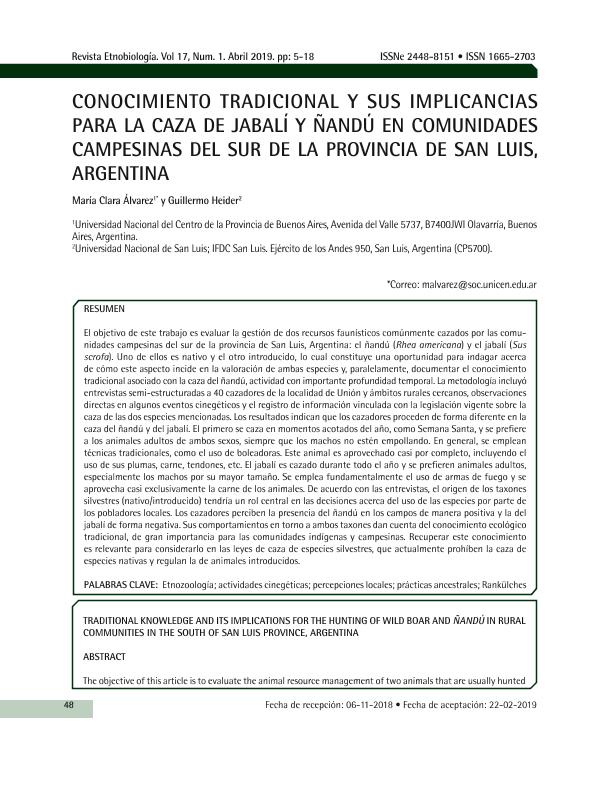Artículo
El objetivo de este trabajo es evaluar la gestión de dos recursos faunísticos comúnmente cazados por las comunidades campesinas del sur de la provincia de San Luis, Argentina: el ñandú (Rhea americana) y el jabalí (Sus scrofa). Uno de ellos es nativo y el otro introducido, lo cual constituye una oportunidad para indagar acerca de cómo este aspecto incide en la valoración de ambas especies y, paralelamente, documentar el conocimiento tradicional asociado con la caza del ñandú, actividad con importante profundidad temporal. La metodología incluyóentrevistas semi-estructuradas a 40 cazadores de la localidad de Unión y ámbitos rurales cercanos, observaciones directas en algunos eventos cinegéticos y el registro de información vinculada con la legislación vigente sobre la caza de las dos especies mencionadas. Los resultados indican que los cazadores proceden de forma diferente en la caza del ñandú y del jabalí. El primero se caza en momentos acotados del año, como Semana Santa, y se prefiere a los animales adultos de ambos sexos, siempre que los machos no estén empollando. En general, se emplean técnicas tradicionales, como el uso de boleadoras. Este animal es aprovechado casi por completo, incluyendo el uso de sus plumas, carne, tendones, etc. El jabalí es cazado durante todo el año y se prefieren animales adultos,especialmente los machos por su mayor tamaño. Se emplea fundamentalmente el uso de armas de fuego y se aprovecha casi exclusivamente la carne de los animales. De acuerdo con las entrevistas, el origen de los taxones silvestres (nativo/introducido) tendría un rol central en las decisiones acerca del uso de las especies por parte de los pobladores locales. Los cazadores perciben la presencia del ñandú en los campos de manera positiva y la del jabalí de forma negativa. Sus comportamientos en torno a ambos taxones dan cuenta del conocimiento ecológico tradicional, de gran importancia para las comunidades indígenas y campesinas. Recuperar este conocimiento es relevante para considerarlo en las leyes de caza de especies silvestres, que actualmente prohíben la caza de especies nativas y regulan la de animales introducidos. The objective of this article is to evaluate the animal resource management of two animals that are usually hunted by farmer communities that live in the South of San Luis (Argentina): ñandú or Greater rhea (Rhea americana) and wild boar (Sus scrofa). One is native and the other is exotic, which constitutes an opportunity to understand how this fact influences the species assessment. In parallel, we documented the traditional knowledge associated with ñandú hunting, activity with an important temporal depth. The methods included semi-structured interviewing to 40 hunters from Union locality and nearby rural areas, non-participant observation of hunting events, and recording information on the current laws that regulate the hunting of the mentioned species. Results indicate that hunters proceed differently in the hunting of the ñandú and the wild boar. The former is hunted in specific moments of the year, like Easter week, and adult animals of both sexes are preferred, as long as they were not hutching. In general, traditional techniques are used, as the boleadoras (throwing weapon made of stones and interconnected cords, used to hunt animals by entangling their legs). Almost all the parts of this bird are used, including the feathers, meat, bones, and tendons. The wild boar is hunted in any moment of the year and the larger male animals are preferred. Fire weapons are used and only the meat is consumed. According to the interviews, the origin of the taxa (native versus exotic) would have an important weight in the decisions on the management of the species by local farmers. The ñandú is perceived in a positive way while the wild boar is viewed as negative. The behaviors around these taxa are related with the traditional ecological knowledge (TEK). It is proposed that this knowledge should be regained and included in the current laws that regulate the hunting of wild animals.
Conocimiento tradicional y sus implicancias para la caza de jabalí y ñandú en comunidades campesinas del sur de la provincia de San Luis, Argentina
Título:
Traditional knowledge and its implications for the hunting of wild boar and ñandú in rural communities in the south of San Luis province, Argentina
Fecha de publicación:
04/2019
Editorial:
Asociación Etnobiológica Mexicana
Revista:
Etnobiología
ISSN:
1665-2703
e-ISSN:
2448-8151
Idioma:
Español
Tipo de recurso:
Artículo publicado
Clasificación temática:
Resumen
Archivos asociados
Licencia
Identificadores
Colecciones
Articulos(CCT - SAN LUIS)
Articulos de CTRO.CIENTIFICO TECNOL.CONICET - SAN LUIS
Articulos de CTRO.CIENTIFICO TECNOL.CONICET - SAN LUIS
Articulos(INCUAPA)
Articulos de INVESTIGACIONES ARQUEOLOGICAS Y PALEONTOLOGICAS DEL CUATERNARIO PAMPEANO
Articulos de INVESTIGACIONES ARQUEOLOGICAS Y PALEONTOLOGICAS DEL CUATERNARIO PAMPEANO
Citación
Alvarez, María Clara; Heider, Guillermo; Conocimiento tradicional y sus implicancias para la caza de jabalí y ñandú en comunidades campesinas del sur de la provincia de San Luis, Argentina; Asociación Etnobiológica Mexicana; Etnobiología; 17; 1; 4-2019; 5-18
Compartir




